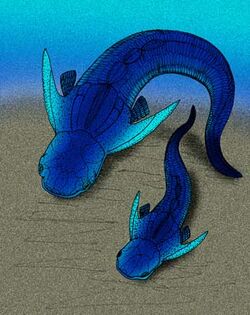Biology:Quasipetalichthys
| Quasipetalichthys | |
|---|---|

| |
| Scientific classification | |
| Kingdom: | |
| Phylum: | |
| Class: | |
| Order: | |
| Family: | |
| Genus: | Quasipetalichthys
|
| Species: | Q. haikouensis
|
| Binomial name | |
| Quasipetalichthys haikouensis Liu, 1973
| |
Quasipetalichthys haikouensis is the type and only known species of the extinct petalichthid placoderm, Quasipetalichthys. Fossil remains of Quasipetalichthys have been found in the Middle Devonian, Givetian faunal stage of China .
Fossils
Quasipetalichthys is known primarily from two poorly preserved skulls from the Givetian-aged Haikou Formation of Haikou, Kunming, China, where they were found in association with remains of antiarch placoderms such as Bothriolepis sinensis, and Hunanolepis.[1] The larger of the two skulls may have been around 10 cm (3.9 in) in length.[2]
Phylogeny
Q. haikouensis is considered a basal petalichthyid (though in 1978 Denison referred to it as being "aberrant"[2]). In Zhu's 1991 redescription of Diandongpetalichthys,[3] Quasipetalichthys was placed within a different family: the Quasipetalichthyidae, and was regarded as the sister group of the more advanced Macropetalichthyidae, with Diandongpetalichthys serving as the primitive sister group of these two taxa.[4]
Neopetalichthys may be very closely related to Quasipetalichthys, and may or may not be placed together within Quasipetalichthyidae in a more completed phylogeny. Whether or not Neopetalichthys is included in the family, Eurycaraspis is placed in Quasipetalichthyidae as a sister taxon toQuasipetalichthys.
Distribution and habitat
The Haikou Formation, the only known set of rocks that has produced fossils of Quasipetalichthys, appears at the earth's surface in south-central China.[5][1] Other paleontological investigations into these sediments have produced spores and macrofossils from Devonian plants such as the Lycopods (classified as Lycopodophyta or Lycopsida)).[5][6][7] These plant remains often occur alongside those of Placoderms such as Bothriolepis which implies a very near-shore or freshwater environment for this geologic formation.[7]
References
- ↑ 1.0 1.1 Long, John A. (1993). Palaeozoic vertebrate biostratigraphy and biogeography. Johns Hopkins University Press. pp. 369 (page 266). ISBN 9780801847790.
- ↑ 2.0 2.1 Denison, Robert (1978). Placodermi Volume 2 of Handbook of Paleoichthyology. Stuttgart New York: Gustav Fischer Verlag. pp. 40. ISBN 978-0-89574-027-4.
- ↑ Zhu, M. "New information on Diandongpetalichthys (Placodermi: Petalichthyida)." Early vertebrates and related problems of evolutionary biology. Science Press, Beijing (1991): 179-192.
- ↑ Zhu, Min; Wang, Junqing (October 1996). "A NEW MACROPETALICHTHYID FROM CHINA, WITH SPECIAL REFERENCE TO THE ZOOGEOGRAPHY OF THE MACROPETALICHTHYIDAE (PLACODERMI)". Vertebrata PalAsiatica 34 (4): 253–268. http://www.ivpp.cas.cn/cbw/gjzdwxb/xbwzxz/200812/W020090813369930445831.pdf.
- ↑ 5.0 5.1 L. Gao. 1981. Devonian Spore Assemblages of China. Review of Paleobotany and Palynology. 34:11-23
- ↑ C. S. Li. 1990. Minarodendron cathaysiense (gen. et comb. nov.), A lycopod from the late Middle Devonian of Yunnan, China. Palaeontographica Abteilung B. 220:97-117
- ↑ 7.0 7.1 S. Hao, J. Xue, and Q. Wang, Z. Liu. 2007. Yuguangia ordinata gen. et sp. nov., a New Lycopsid from the Middle Devonian (Late Givetian) of Yunnan, China, and Its Phylogenetic Implications. International Journal of Plant Sciences. 168(8):1161-1175
External links
Wikidata ☰ Q7269517 entry
 |

